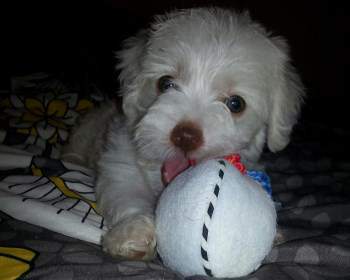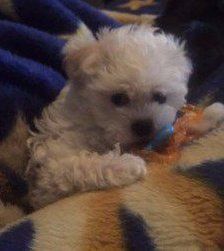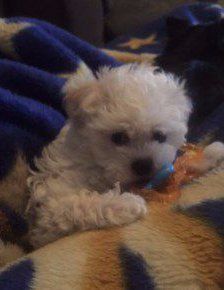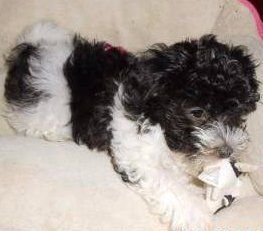Maltipoo Teething and Chewing
Overview
There's a few phases to get through when you have a puppy, and the teething phase is certainly one of the most challenging.
When a Maltipoo is teething, there is quite a bit of discomfort and itching taking place. This can send a pup into a frenzy of sorts, as he looks for something, anything, to cure his teething woes.
However, despite what is happening, there are steps that you can take your help your puppy and keep your belongings from being destroyed.
Here, we'll look at the age that this takes place and what you can do to help your Maltipoo as your pup transitions through this stage.
Please note:
PetMaltipoo is reader-supported. Some of the product suggestions on this page are affiliate links. As an Amazon Associate we earn from qualifying purchases. This is at no extra cost to you and helps us continue creating useful content.
The Maltipoo Puppy Teething Timeline
The age that a Maltipoo puppy
starts the teething phase of the milk teeth falling out and the adult teeth growing in is just around the 4 month mark. There will, of course, be some early and late bloomers. Typically, teething is complete around the 8 month mark.
The order of this is usually as follows:
- 4 Months old – the adult incisors begin to grow in
- 5 months old - the adult canine teeth begin to grow in
- 6 months old - the adult molars begin to grow in
- By 8 months old, a puppy should have all adult dog teeth ascended and teething will end.
How to Help When Your Maltipoo is Teething
Puppies have little self-control, so you'll need to take some steps to prevent your puppy from chewing on non-toy items and to help with the itching and discomfort that is taking place.
Here is what you can do:
- Remove shoes, bags, and other personal items from the floor and place them up high. If a teething puppy chews on his owner's shoes, the pup is not to blame.
2. Supervise.
This is one of the best methods to avoid all sorts of issues, but also one that is often overlooked leading to lots of grief.
Young teething puppies must not have free reign in the house. Not to mention that allowing a pup to roam around a room allows for puddles of pee and piles of poo.
When your can have your puppy near you, keep your pup on a harness and tether him to you with a 6 foot, light-weight leash.
You can simply slip the end of the leash around your wrist or secure it through your belt loop. And do be sure to use a harness, and not a collar, to prevent neck injury as your Maltipoo follows you around.
When you cannot keep an eye on your puppy, keep him in one designated area. One of the best ways to set up a comfortable and safe area is to use an indoor canine playpen. These are also great for potty training and to keep a puppy's needed essentials right near him if he has separation anxiety.
Within the playpen will be a quality bed, water, food (if you won't be home), and teething toys (much more ahead).
Below is the leash and harness that we've discussed, as well as one of the playpens that we recommend.
If you cannot see the images, try a refresh. And on mobile, you may need to turn your screen horizontal to see all 4. Next, we'll talk about how to find the right teething toys, and how to react if your teething puppy is misbehaving.
3. Provide effective teething toys.
Offering cold ropes can really help with both pain and itching, and it helps with swelling that often occurs around the teeth.
Our top recommended toys for teethers are below.
This includes both those with massaging nubs and a great set of properly sized rope toys (don't forget to wet and freeze these). If you do not see the images, try a refresh. And on mobile, you may need to turn your screen horizontal to see all 4.
4. React properly to non-toy chewing.
Note
that the following works for both teething puppies and adult Maltipoo with destructive chewing behaviors.
If you are keeping your Maltipoo right next to you, and in a playpen when you can't supervise, there will be very few times that you catch him gnawing away at your carpeting or destroying your kitchen table legs.
However, if you do come upon this, be sure to react this way:
1. Interrupt.
Clap your hands together, loud and/or give a firm 'No'.
Some puppies are so used to hearing 'no' that they will not take a pause. The same goes for clapping if a pup is accustomed to loud household noises.
In these cases, using a behavior interrupter can work well. These let out a short hissing noise that will cause a teething pup to stop in his tracks. It's completely harmless, the hiss just works exceptionally well to immediately get his attention. If you think that you might want to try this, the Company of Animals Pet Corrector
 is quite effective.
is quite effective.
2. Redirect.
Offer your Maltipoo one of his approved chew toys. If you must give some extra encouragement, use a playful voice and wave the toy.
Additionally, placing a small dab of peanut butter on the toy can draw the pup to it. This is healthy for a pup to eat, tastes great, and the scent works as a great lure.
When your pup takes the toy, give great praise, and allow him to enjoy himself.
-min-221x335-1920w.jpg)
Preventing a Maltipoo for Chewing on Table Legs and Other Objects
Though we've talked about moving your shoes and picking up small objects from the floor, what about things like the sofa legs, kitchen table legs, chair legs, or the carpeting? These four items seem to be those that Maltipoos gravitate towards when teething.
In addition, adult Maltipoos of any age may develop a chewing habit, and may also target these things.
No matter your dog's age, the advice is the same.
If you are keeping your Maltipoo tethered to you, and when you cannot do that you're keeping your pup in his/her playpen, there'll be very few times that those furniture pieces can become the object of chewing.
This said, if this does happen, you can use a chewing deterrent spray. Keep in mind that these work to varying degrees, depending on the puppy. Most are formulated with bitter apple, which is a taste that most canines simply hate. However, there will always be that occasional dog that somehow powers through it to reach what he wants to chew on. Or, despite what should be an awful taste, a dog may not mind the flavor.
Though, one element that can make these less effective is how they are used. These are meant to be sprayed on objects every 2 to 3 days. If you forget to use the spray, the taste will fade off and it won't work to its full effect.
If you'd like to try a chewing deterrent spray, Grannicks Bitter Apple Chew Deterrent
 is a good choice.
is a good choice.
Nipping While Teething
it's not uncommon for a Maltipoo puppy to get carried away when nibbling at his owner's fingers, or to play too rough and digging his teeth in. To prevent finger-nibbles in the first place, do not allow your puppy to nibble on your fingers at all. All chewing urges should be redirected to toys.
In some case, a Maltipoo can have a frenzy of sorts, and behavior can seem quite aggressive. In these cases, it will be a matter of providing the right toys, and following advice to train aggressive Maltipoo dogs.





